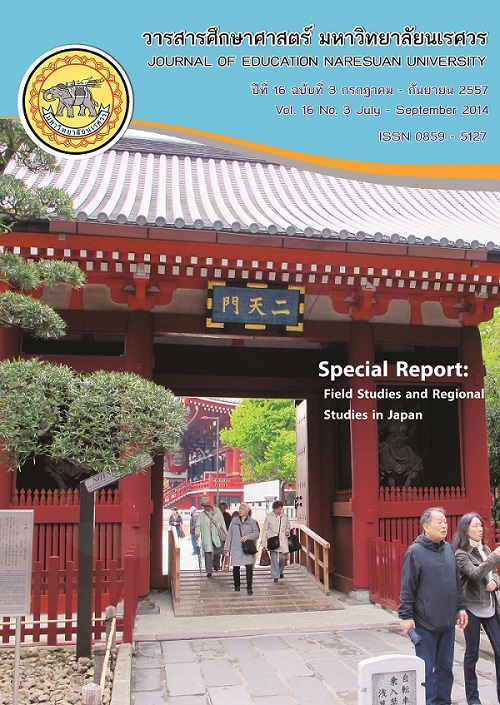การพัฒนาระบบการเทียบโอนผลการเรียนรู้และประสบการณ์สำหรับสถานศึกษา สังกัดสำนักงานคณะกรรมการการอาชีวศึกษา
Main Article Content
Abstract
บทคัดย่อ
การวิจัยนี้มีเป้าหมายสำคัญ คือ การพัฒนาระบบการเทียบโอนผลการเรียนรู้และประสบการณ์สำหรับสถานศึกษาสังกัดสำนักงานคณะกรรมการการอาชีวศึกษา โดยมีขั้นตอนการวิจัย 3 ขั้นตอนดังนี้ ขั้นตอนที่ 1 เป็นการศึกษาเชิงเปรียบเทียบการเทียบโอนผลการเรียนรู้ของ 6 ประเทศที่พัฒนาแล้ว ได้แก่ สหรัฐอเมริกาแคนนาดาออสเตรเลีย อังกฤษ เกาหลี และญี่ปุ่น โดยการวิเคราะห์เอกสาร และศึกษาความต้องการการเทียวโอนผลการเรียนรู้ของผู้บริหารสถานศึกษาอาชีวศึกษา จำนวน 199 คน ขั้นตอนที่ 2 เป็นการยกร่างระบบการเทียบโอนผลการเรียนรู้ที่ได้จากข้อมูลการศึกษาในขั้นตอนที่ 1 และให้การรับรองโดยการสนทนากลุ่มของผู้เชี่ยวชาญ จำนวน 9 คน และขั้นตอนที่ 3 เป็นการวิเคราะห์ความเป็นไปได้ในการนำระบบการเทียบโอนผลการเรียนรู้ไปปฏิบัติในสถานศึกษาโดยผู้บริหารสถานศึกษาอาชีวศึกษา จำนวน 404 คน
ผลการวิจัยปรากฏดังนี้ ระบบการเทียบโอนผลการเรียนรู้และประสบการณ์สำหรับสถานศึกษา สังกัดสำนักงานคณะกรรมการการอาชีวศึกษา ประกอบด้วย 4 องค์ประกอบหลักดังนี้ 1) คณะกรรมการการเทียบโอน ควรประกอบด้วย คณะกรรมการ 2 ชุดได้แก่ คณะกรรมการอำนวยการ และคณะกรรมการดำเนินการ 2) การเทียบโอนควรครอบคลุม 2 ลักษณะ คือ การเทียบโอนผลการเรียน และการเทียบโอนผลการเรียนรู้จากประสบการณ์ 3) วิธีการเทียบโอนความรู้ควรประกอบด้วย 4 ลักษณะวิธี ได้แก่ การเทียบโอนผลการเรียนจากหลักสูตรเดียวกัน การเทียบโอนผลการเรียนจากหลักสูตรอื่น การเทียบโอนผลการเรียนจากหลักสูตรประกาศนียบัตรวิชาชีพและวิชาชีพชั้นสูงของสถานศึกษาอาชีวศึกษา รวมทั้งการเทียบโอนผลการเรียนจากหลักสูตรวิสามัญระดับชั้นมัธยมศึกษาตอนปลาย และการเทียบโอนผลการเรียนรู้ของนักศึกษาพ้นสภาพในหลักสูตรวิชาชีพ และวิชาชีพชั้นสูงของสถานศึกษาอาชีวศึกษา และ 4) กระบวนการเทียบโอนความรู้ควรประกอบด้วย 5 ขั้นตอน ได้แก่ การวางแผน การจัดองค์การ การดำเนินการ การติดตามประเมินผล และการปรับปรุงพัฒนา
คำสำคัญ: ระบบการเทียบโอน/ คณะกรรมการการอาชีวศึกษา
Abstract
This research aimed at developing a system for credit transfer of prior learning and experience for the institutes under the Office of Vocational Education Commission. The research methodology employed mixed methods which followed three phases. Firstly, was a comparative study of the systems and procedures of credit transferring among 6 selected countries and, followed by studying the need assessment of a credit transfer system from 199 vocational administrators. In this phase, the comparison was based on documentary analysis, and the statistical analysis of the needs was based on average and standard deviations. Secondly, the drafting of a tentative system for credit transfer of prior learning and experience was made, based on the research results from Phase 1 and the validation by a group discussion process among 9 experts. Thirdly, the evaluation of the possibility of the drafted system was made, using a questionnaire, collected from 404 administrators of vocational education institutes. The statistical data were analyzed by means and standard deviations.
The results indicated as follows; the systems of credit transference consisted of form components: a) credit transferring committees comprised two groups, the administrative committee and the steering one, b) the transference covered two aspects; learning achievement and working experiences, c) the transferring procedures composed of four characteristics; transferring with in the same curriculum, transferring from the other ones, transferring from the lower and higher certificate in vocational education, and from the curriculum of secondary education, and transferring from the achievement of the drop-put students in lower and higher certificates of vocational education, and d) the process of transference had five respective step as follows; planning, organizing, executing, evaluating and improving.
Keywords: System for Credit Transfer/ VocationalEducation CommissionArticle Details
The owner of the article does not copy or violate any of its copyright. If any copyright infringement occurs or prosecution, in any case, the Editorial Board is not involved in all the rights to the owner of the article to be performed.


